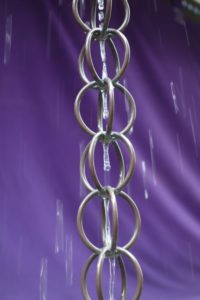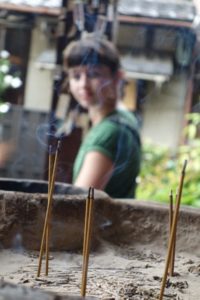 My family and I are back in Japan “on the way home” from our 10 weeks in Asia; almost 2 months ago we visited Kiyomizudera, the temple of pure water, in Kyoto — and there’s a scene that keeps playing in my mind.
My family and I are back in Japan “on the way home” from our 10 weeks in Asia; almost 2 months ago we visited Kiyomizudera, the temple of pure water, in Kyoto — and there’s a scene that keeps playing in my mind.
We went early in the morning, and the grounds were echoing with peacefulness… until a group of Japanese schoolchildren came bounding down the path. Patty, Emma (now 13), Max (11) and I were enjoying the spring for which the temple is named, water cascading from the deep in the mountain. Ancient stones watch over the scene, moss creeping into the deeply carved kanji prayers. The kids were slightly rambunctious as they came around the corner, but it was actually the teachers who were most shrilly breaking the morning’s peace. They kept shouting for the kids to line up and then get into the right spot for a photo.
This is, perhaps, an archetypal story of contemporary Japan; clearly, for the teachers, the appearance of the experience was the point. Been there, got the photo, done that. But that’s not what’s kept this in my mind for the last month. It isn’t these particular teachers, but all of us:
Are we more interested in the appearance of the thing, or the thing itself?
For example…
- Do we want our employees to look busy, or to actually accomplish?
- Do we want our children to appear to do as they’re told, or to have inner motivation?
- Do we want to purchase the appearance of beauty, or revel in the beauty that only comes from within?
- Do we want people to act like they respect us, or to earn respect?
I remember, way back, when I was a teacher. After years in a military-like academy, a boy came to our school. ”How come you let the kids call you by your first names here, it’s not respectful?” He told me that in his old school, children called the teachers “sir” or “mam.” I asked, “Did you actually respect all those teachers, or did you just say ‘sir’ because you didn’t want to get in trouble?”

There is a seduction of the surface. It’s easy to see. It’s easy to put in a photo. It’s easy to say, “We’re doing it right.” It’s just plain easier. As stress levels rise and we are too busy even to be busy, we skim. The surface is faster. Depth takes reflection. It takes ambiguity and curiosity and the effort of turning the wheel firmly enough to leap out of the deeply worn ruts in the roads of our minds.
I’ve written before about the challenge of focusing not just on behavior, but on the drivers. In our contemporary lives, there are a conspiracy of pressures that make it very challenging to do so.
I wanted to ask the Japanese teachers, “why are you bringing the kids here?” Not with any hostility, but because I’m curious if they’ve even thought about it. Are they doing this because “that’s what you do,” or because they have a particular goal? Then, we could consider, “is this way of doing the activity optimally contributing to your goal?”
Since my Japanse isn’t nearly good enough (and the teachers were much too busy getting the kids to the next temple), I’ve been asking myself these questions.
Am I staying on the surface because it’s comfortable and efficient and I’m too busy to live my own life? Or am I really engaging in each day?
Am I going through my days because “that’s what you do”? Or am choosing the moments intentionally?
All too often in these last two months, I’ve been efficiently skimming the surface. I’d love to tell you that I’ve figured out how to be awake every day… but maybe it’s a gradual process. Like dawn sunlight gradually reaching in the window to wake us up, growth unfolds. For now I’d like to ask myself these questions, and at least notice when I’m not noticing.

